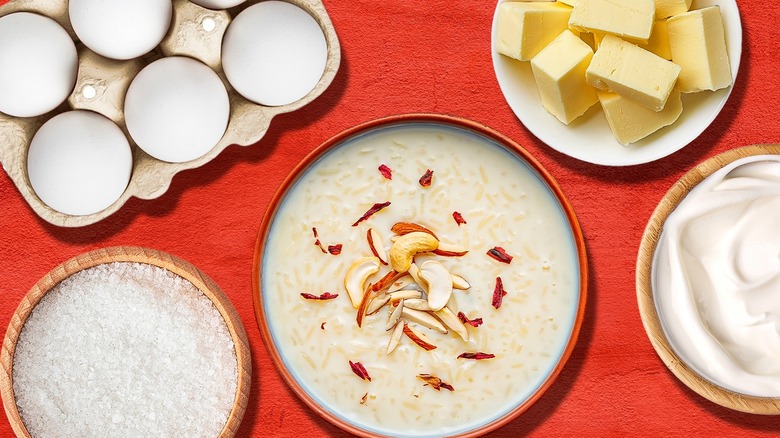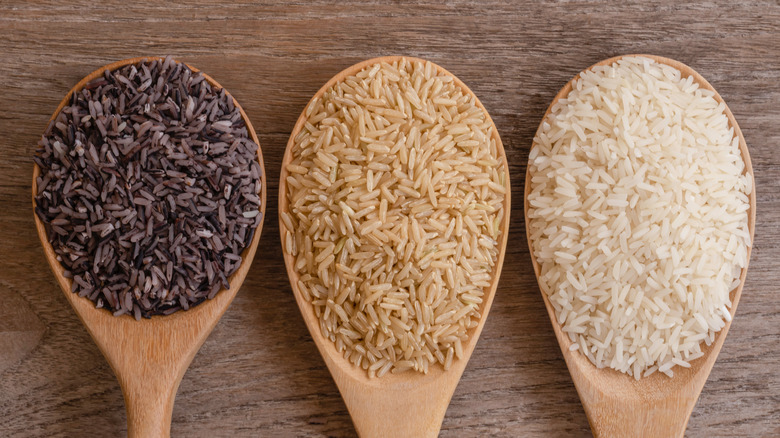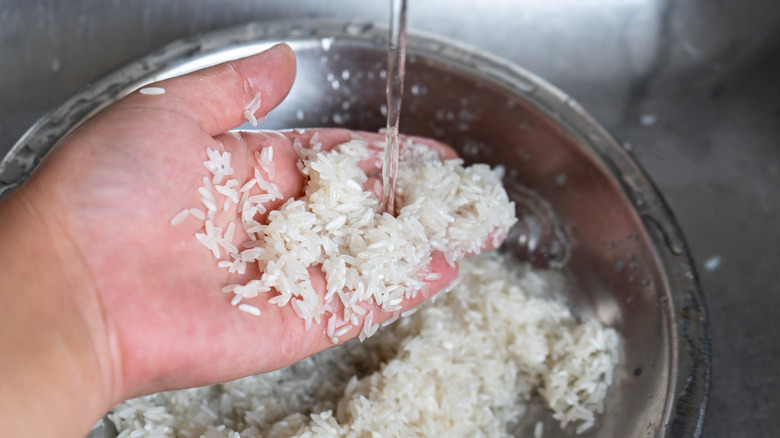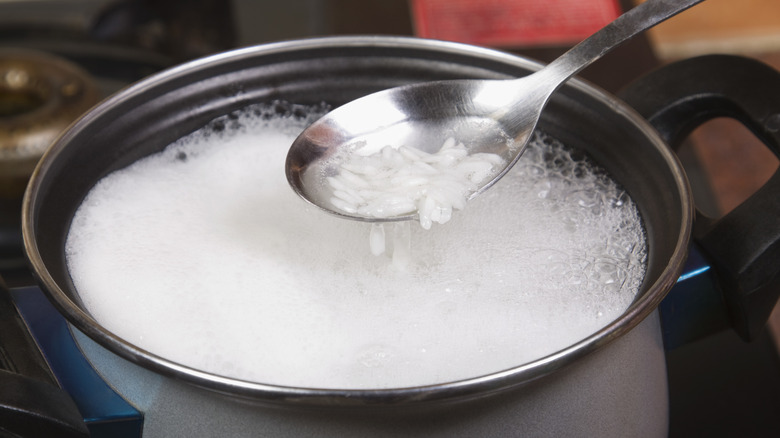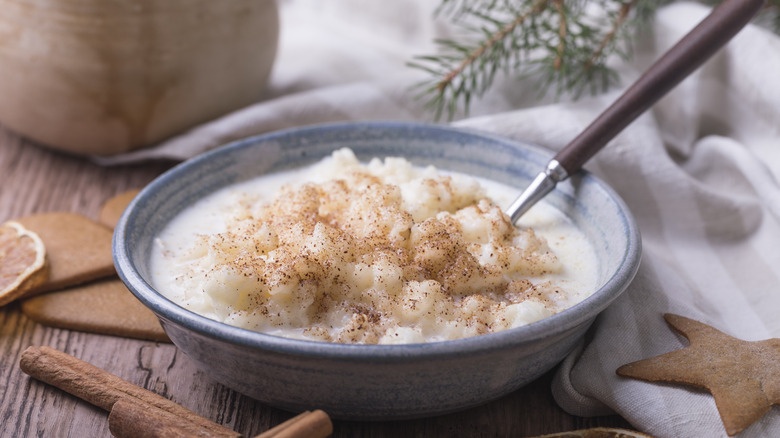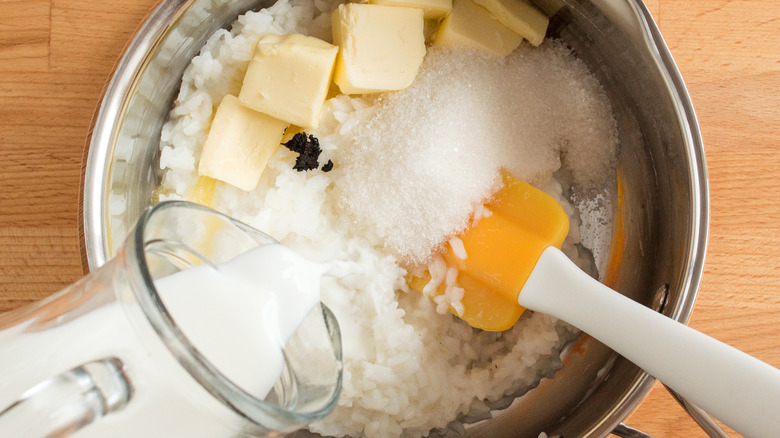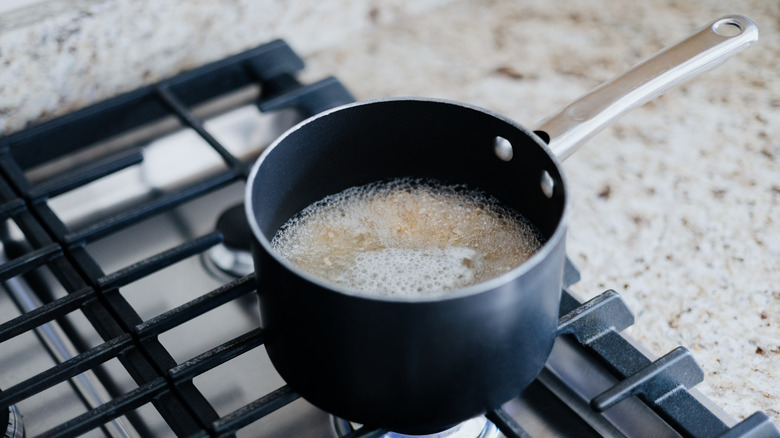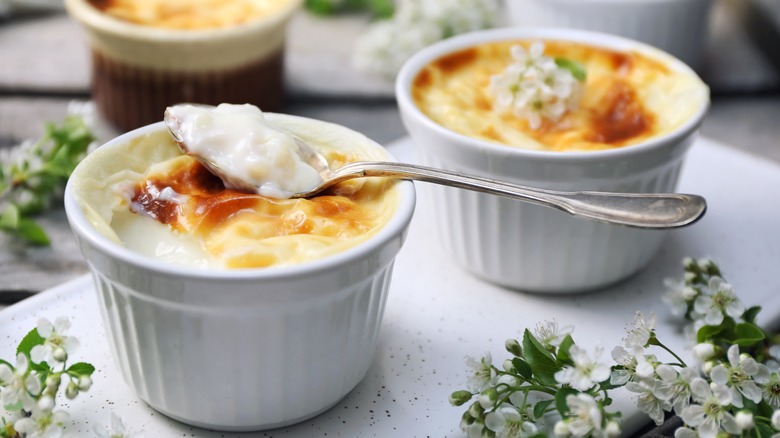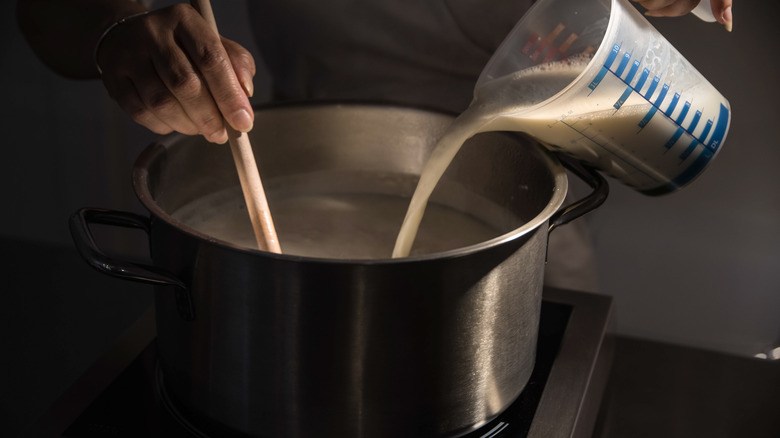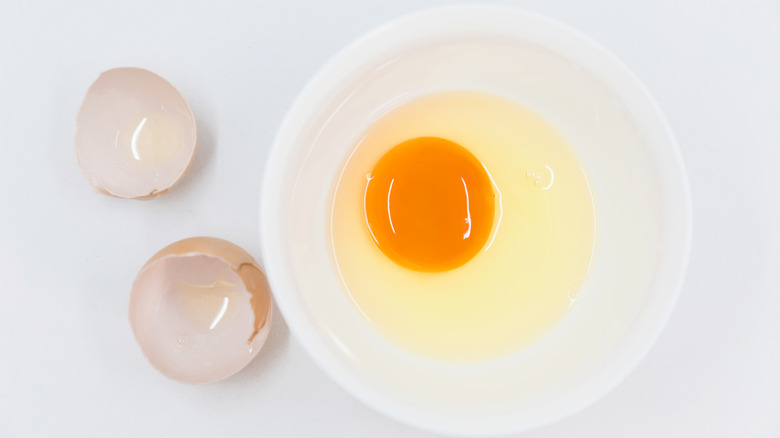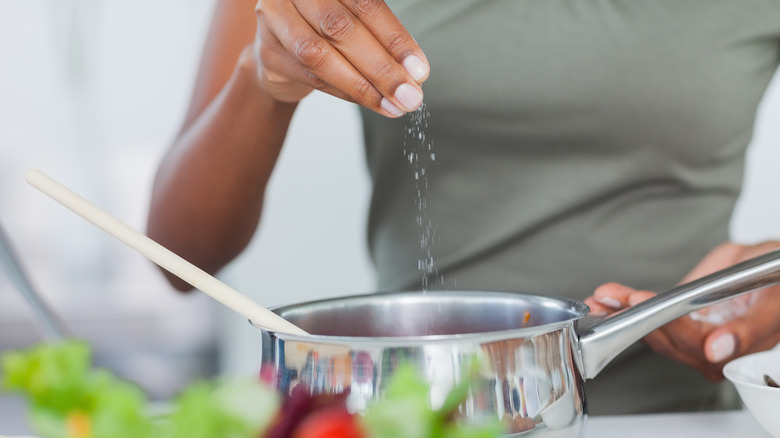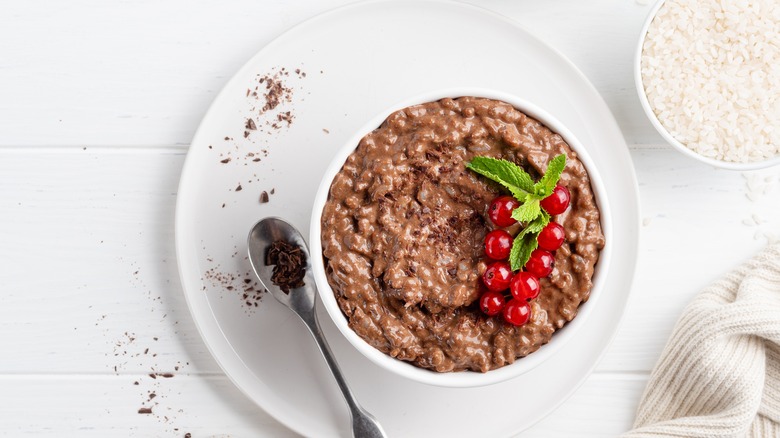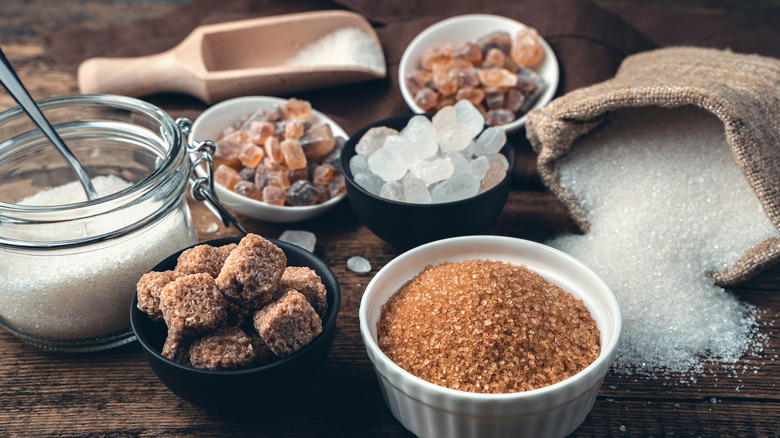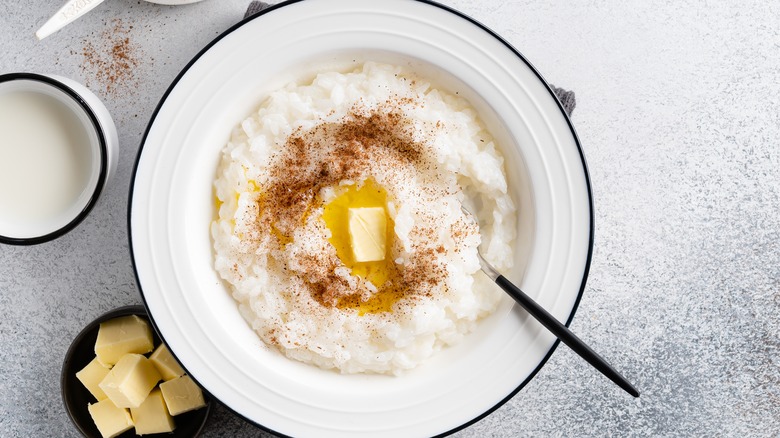Mistakes Everyone Makes When Cooking Rice Pudding
Rice pudding is a homemade classic. This is a dessert that's versatile enough to fit all seasons and one that calls for a handful of ingredients that you probably have in your pantry. As it's such a homey dish, you'd think there aren't many mistakes you can make with it, but because of its unpretentious and straightforward character, there is no way to cover up the faults. Even seasoned home cooks need time to learn how to perfectly execute a rice pudding with the ideal ratio of delicate sturdiness and smooth creaminess.
To demystify the cooking process and minimize damage, we referred to four experts and asked them to point out the most common mistakes we make when cooking rice pudding. We interviewed the pastry chef and instructor Emily Laurae Carter and Blair Lonergan, an author who regularly shares her family recipes on The Seasoned Mom. We also consulted with the pastry chef Elisa Lyew from Elisa's Love Bites and Ann Ziata, a chef at the Institute of Culinary Education's New York City campus. These experienced professionals weighed in on all the parts of the cooking process, reflected on the possible errors, and provided practical advice that anyone can implement in their home kitchen.
Apart from being utterly comforting, rice pudding can also be an indulgent affair. It's a classic for a reason, and it's finally time to part with the stiff, soupy, gummy, and mushy rice pudding abominations by preventing these simple mistakes.
Using the wrong rice
A common mistake we often make with many rice dishes is thinking that all varieties of the grain are created equal and that they can be used interchangeably. There are many types of rice, and though it's true that some share similar characteristics and can be swapped, you should carefully choose the one you want to use in this pudding. In many dishes, rice is merely a sidekick, but here, it is the star of the show and the ingredient that dictates whether the mix will attain that signature pudding-like texture.
"I recommend using short or medium-grain rice," says pastry chef Lyew. She explains that these varieties tend to have more starch, which is slowly released as the pudding cooks. "Starch is key for thickening the custard, so choosing the right type of rice is important for a creamy pudding," she clarifies. Lyew highlights Italian arborio rice — a variety traditionally used for risotto — as her firm favorite, but she also mentions that sushi rice can provide amazing texture.
Chef Ziata takes a more flexible approach and claims that it all comes down to personal preference. She even mentions that you can use brown rice to give it an earthy touch, but she concludes that white rice is her choice simply because "it's such a comfort food."
Rinsing the rice
Rinsing or not rinsing the rice seems to be the most controversial issue when making rice pudding, with many opposing views and different recipe instructions. Those who argue that rice needs a rinse before going into the pudding often mention that a quick wash only removes excess starch that makes the pudding too soft and turns it into mush. Another point they usually stress is that rinsing is necessary to get rid of all impurities.
On the other hand, some industry professionals, including the experts we talked to, don't agree with this approach and generally claim that the right method is to skip the rinse. Lyew explains that she does not practice rinsing the rice before it is used. She prefers to preserve all of that starch that will lend beautiful creaminess to the pudding. Lonergan agrees with this method and believes it's just not something that you should be obligated to do. "Instead, the extra starch on the rice yields a thicker, creamier texture in the pudding," she explains. Lonergan also mentions that she skips the toasting step, which some chefs favor as the first step in the cooking process.
Messing up the rice-to-liquid ration
Just like any other dessert, rice pudding requires precise measurements. This is especially important when it comes to the rice-to-liquid ratio, which is a major factor that determines whether the pudding will be creamy and compact or turn into a runny mess.
Lonergan warns that not using enough liquid will give you "a pudding that's way too thick or dry." On the other hand, using too much liquid that rice can't absorb will result in an unappetizing soupy consistency. Ziata states that it's paramount to be exact with ratios and measures, and to pay attention to the cooking time. Using too much liquid gives rice the opportunity to soak it up, resulting in mushy, overcooked rice.
Lyew explains that we should be extra careful with non-dairy milk and cream. Milk has a higher fat percentage, and simply swapping it with the same amount of non-dairy alternatives will not deliver the same consistency. "Non-dairy rice puddings will require the addition of extra starches (like cornstarch or tapioca starch) to achieve the same thickness as a traditional recipe made with whole milk," she clarifies.
Ignoring the serving temperature
One rice pudding mistake that often goes under the radar is not paying attention to the serving temperature. One of the best characteristics of rice puddings is that you can serve them warm or well-chilled, depending on preference, but Ziata warns that cold pudding requires "a greater quantity of sweetener and aromatic ingredients."
Ziata explains that deciding whether you're serving it hot or cold is the first thing you should do. "Heat turns up the volume of flavor and sweetness, while cold temperatures can have a numbing effect on the palate," she elaborates. Ziata points out that ice cream is the perfect example to illustrate this as it often seems that melted ice cream is sweeter than frozen. If you're serving the pudding warm, there should not be any problems, but if you plan to refrigerate it, taste it while it's hot and adjust the flavorings and sweetness. Ziata suggests you should aim for a version that is "just a bit too sweet and too strong."
You're over-stirring
If you're whipping up your rice pudding on the stove, regular stirring is essential to attain uniform consistency and prevent a burnt bottom. Baked versions don't require the same devoted approach, but some recipes suggest taking it out mid-bake, mixing it, and returning it to the oven to finish cooking. Ziata explains that stirring will help release more starch, which gives you a thick and creamy pudding. But it also ensures that you scoop all the rice from the sides and the bottom, which prevents some parts from cooking faster than others.
Though Lonergan agrees that mixing the pudding is important, she warns that a common consequence of too much stirring is a gloopy pudding. She explains that vigorous mixing can break the grains. As a result, they release excess starch, and "you can end up with a mushier texture than you'd like." She emphasizes that it's especially important to avoid over-stirring at the beginning of cooking. Ziata also warns that agitating reduces the temperature of the pudding, so if you need to amp up the heat, leave it to bubble without stirring. She also points out that higher heat will call for more mixing.
Speeding up the process
One of the most common mistakes people make with rice pudding is thinking you can somehow reduce the cooking time by turning on high heat. Ziata explains that this method speeds up evaporation, leaving you with unevenly cooked grains, while Lyew further elaborates that this practice "can cause the milk to curdle and the liquid to reduce too quickly while the rice is still undercooked."
The best approach for rice pudding is cooking it low and slow. Lonergan recommends letting the pot come to a boil before turning down the heat. She suggests leaving the rice to gently simmer for approximately 40 minutes, explaining that this method yields a thick pudding with soft rice kernels. Lyew agrees with the approach: "Cooking the rice pudding gently over low heat allows the starch to release slowly and properly thicken the mixture." Ziata adds that medium heat is the right option for rice you want to cook with milk and sugar. Experts also stress that you should not skip stirring despite cooking the pudding on low or medium heat.
Thinking that stovetop method is the only way to go
Most rice pudding recipes rely on the classic stovetop method in which the rice is cooked with milk, sugar, and other optional add-ons until it's tender and fully cooked. Though the technique is generally successful, it's time-consuming and calls for constant attention and regular stirring. If you think it's too demanding, remember there are other, less laborious options.
Baked rice pudding is not a novelty, but it's often undeservingly overshadowed by the stovetop method. In this version, rice, sugar, milk, and all the flavorings you want to add are thrown into a deep baking dish or ramekins, and you just leave the pudding in the oven to bake. Optionally, you can check on the pudding and stir to ensure there are no kernels sticking to the bottom. Lyew is a big fan of this method. "The oven provides gentle, even heat to cook the rice through perfectly," she explains. Adding that using a water bath – which entails a larger baking dish filled with water that will hold the smaller pot with the pudding — is a great way to get that perfectly luscious texture.
If you're planning to serve the pudding chilled, Ziata has interesting advice to leave the rice slightly undercooked and let the pudding cool down overnight. "This will keep the rice from overcooking and becoming too mushy," she clarifies.
Not using the right equipment
Using the wrong equipment for making a stovetop version of rice pudding is not a mistake that will ruin the dish, but you might not get consistent or desirable results. This is an unpretentious and homey dish, and it does not call for special equipment, but you want to make sure to use the right pot and utensils to get the perfect results.
Lyew and Lonergan agree that a heavy-bottomed pot is a must. This could be your favorite Dutch oven or the classic saucepan, but make sure that the bottom is thick. This ensures that the heat will be transferred evenly, which enables consistent cooking and less rice getting stuck to the bottom and scorching. The only other thing you need to have is a wooden spoon or a firm rubber spatula so you can scrape anything that sticks to the bottom.
You should also be careful if you're making a baked version. First, make sure to use an ovenproof dish and choose something that has enough depth. As the rice cooks, the kernels will become plumper and require more space. Also, the mix will bubble away in the oven, and you want to give the rice enough room so it doesn't escape and end up making a mess.
Skipping the eggs
Rice pudding is all about texture, and we all hope to create a homemade version that will reveal a luscious, silky-smooth character once it hits our palate. If you never managed to achieve it, perhaps you skipped the old-school tip of adding eggs. Lyew claims: "Adding tempered eggs during the final stages will give you a silky, creamy consistency." You can use whole eggs or just egg yolks — both versions work — and, as Lyew mentions, try to temper them by adding a small amount of hot milk before mixing them in the pudding.
Lonergan cooks the rice in milk and water and suggests a combination of egg yolks and heavy cream, claiming that it creates "the richest, creamiest, silkiest texture." She emphasizes that she adds the yolks towards the end of cooking, preferably when the pudding is already off the heat. Besides the creamy component, she explains that the yolks act as a binder and keep the pudding firm and set.
Ziata confirms that eggs "add a fantastic creaminess and richness to rice pudding." She also mentions that adding eggs will help your pudding thicken further as it cools down. But the chef warns that adding eggs can be finicky, so make sure to check that they don't overcook or water down the pudding. She also gives an extra tip by suggesting that eggs can boost your favorite morning oatmeal.
Omitting salt
Salt is an essential element in numerous desserts. Even a pinch can make a monumental difference in flavor, and the same rule applies to rice pudding. This dessert is loaded with heavy creaminess and generous sweetness, and the salt is a much-needed addition that will help to offset all other elements. A small amount will not make it salty, but it will create a well-balanced flavor profile that prevents the pudding from being too heavy, cloying, or overwhelming.
"A pinch of salt in your rice pudding recipe helps to enhance the overall flavor, balancing the sweetness and bringing out the subtle notes of the other ingredients," clarifies Laurae Carter. Lonergan explains that it gives desserts "a more deep, complex flavor." She also highlights that salt helps the rice to show off its natural sweetness. Ziata agrees and explains that even the smallest amount of salt can boost flavor. "It'll make everything taste sweeter and more aromatic," she added.
Add salt as the last step and the perfect finishing touch. Use it moderately, and taste as you go. The exact amount will depend on the amount of sugar in the pudding, and you'd probably want to increase it if you're working with sugary add-ons such as caramel that prefer a more salty grip.
Not being creative with flavorings
Cinnamon and vanilla are unquestionable favorites when it comes to rice pudding flavorings. These two classics are go-to options for our experts. Laurae Carter explains that "they add a warm, comforting aroma that pairs perfectly with the creamy rice." Lyew adds that you can use vanilla extract and powdered cinnamon, but she also recommends simmering halved vanilla bean and a cinnamon stick in milk that you can take out before you mix in the rice.
The experts don't shy away from other comforting combinations. Ziata uses warming spices, raisins, and walnuts, while Lonergan adds a neat twist with bourbon-soaked raisins. Though there is nothing wrong with the classics, it's a shame to miss the opportunity to be more adventurous with flavors and textures. "Rice pudding is a very simple dish, so folks should feel free to get creative with the flavors," Lonergan says.
Laurae Carter suggests adding a floral note with rose water and orange blossom water, but make sure not to go overboard as these can be quite potent. She also likes to incorporate other dried fruit, just like Lonergan, who suggests dried cranberries, cherries, or apricots. Lonergan also advocates for citrus zest to brighten the pudding and a handful of chopped and toasted nuts to add texture. Ziata favors the use of pistachios, dates, and cardamom. Her advice is to choose "strong flavors and use them in small amounts." Also, don't forget about chocolate and fruit!
Using only white sugar
White sugar is a standard ingredient in rice puddings, with most recipes recommending granulated or caster sugar that can easily dissolve in milk. This sugar has a neutral profile and only delivers sugary sweetness without depth or complexity. Though using it can't be considered a mistake, sticking to this bland option will prevent you from exploring many alternative sweeteners with bigger personalities that can significantly enrich your rice pudding.
You don't have to look for unusual sweeteners. Start with familiar options. Lyew points out that "liquid sweeteners like honey or maple syrup work great as well." You can add these to the pudding and blend them in, but they also make a great garnish on top of the dish. Lyew is also a fan of coconut palm sugar, which is made with sap sourced from coconut palms that is left to solidify. This sugar has a mild caramel note that can really off its qualities in rice pudding. Similarly, you can use brown sugar or heartier expressions like muscovado to give the pudding a distinctive toffee note. If you're using solid sweeteners, always dissolve them in the milk or the pudding.
Not including butter, cream, or non-dairy alternatives
Most rice pudding recipes start with milk, rice, and sugar. Though the combination usually results in a decent and enjoyable dessert, if you want to make it more decadent, don't skip butter and cream. Laurae Carter explains that milk can be a great base for a creamy rice pudding, but she claims that "adding butter and cream can take your recipe to the next level." She explains that these ingredients create "an ultra-rich" pudding whose luscious character comes through with each spoonful. In her opinion, butter gives more complexity and depth, while the cream makes it extra velvety and smooth. Lyew is also a strong advocate for heavy cream, while Ziata claims that butter and cream "make the rice pudding much richer."
Rice pudding is not a time to play with low-fat substitutes. Use heavy cream and real butter to get the most out of these ingredients. You can add cream at the beginning — it's best to mix it with milk before adding rice. Butter should be diced and added last. When you finish cooking, take the pudding off the stove and mix in butter. Stir until all the butter is melted and nicely incorporated.
Besides dairy products, you can also consider adding plant-based options to your pudding. Lyew suggests full-fat coconut milk as a great alternative to amp up the creaminess, while Ziata recommends oat and almond milk as excellent substitutes.
